Water supply for irrigation in the country - we will not let
Hope only rainfall will not be any self-respecting summer resident. Therefore, in the summer, the organization of reliable and stable watering of the suburban area becomes the primary task. And if you take the matter seriously, you cannot do without organizing a special water supply system on the site.
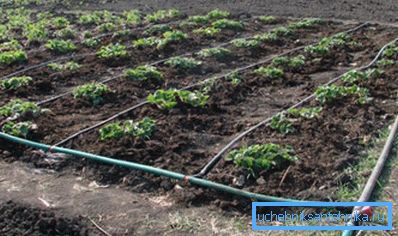
Advantages of suburban water pipes
Some believe that the suburban water supply for watering is an extra thing. Usually, a pipe that passes water passes through the section; there is a tap on it to which, if necessary, irrigation simply connects the hose.
This approach seems to be justified only with a small area of the site, but in this case there are enough weak points:
- it is extremely inconvenient to drag the hose from place to place, on the way it is guaranteed to touch some plants;
- cheap hoses will be twisted, you will have to look for a place to bend and watering will last for a long time;
- the process itself is quite tedious, especially if the area is rather big.
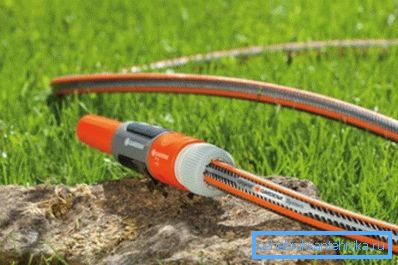
It is for this reason that the real water supply system (most often from PP pipes) is settled down to organize the irrigation of the suburban area. Moreover, the price of such water supply is low, all the work can be done independently, so you only have to spend money on the purchase of pipes and fittings.
Types of water supply for irrigation
There are not so many options here, but the whole choice comes down to whether the plumbing will be permanent or temporary (that is, in the winter it will just have to be removed). Each of these options has strengths and weaknesses.
As for the permanent option, it allows you to:
- to organize the water supply unnoticeably, on the site only releases of pipes from the ground will be visible to which the necessary equipment will be connected during watering. So, the pipes will not get underfoot;
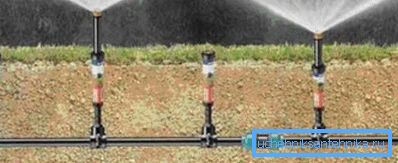
- no need to mess with assembling / disassembling the system;
- leak detection is complicated;
- Those who like to profit from summer cottages in the winter will go empty-handed, they are unlikely to want to dig the frozen ground to steal the PP pipe.
Of the drawbacks, we can note a little more cost (if you hire workers to dig a trench) and labor costs (if you do all the work yourself).
Folding irrigation water supply in the country also has the right to exist, the strengths of this decision include:
- installation speed - in fact, you just need to connect the pipes and lay them according to the project;
Note! If in a stationary water supply system it is necessary to provide a certain bias towards the drain valve to prepare it for winter, then it should not be done dismountable. Pipes are simply laid directly on the ground.
- it is very easy to repair - A small fountain of water will be visible in the place of the leak.
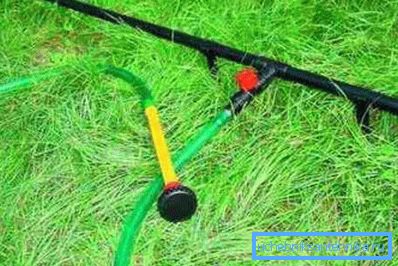
The disadvantages include the need for its assembly and disassembly, if the cottage is not protected. In addition, the pipes lying under their feet interfere - and the cart will not pass along the path, and people will stumble.
Water supply design and materials selection
Conventionally, the whole process can be divided into such stages as: drawing up a scheme of a water supply system, counting on the basis of this document the need for materials and, actually, installation. Laying pipes resembles a little layout for the apartment, but the requirements put forward are not as rigid.
Design and selection of materials
Watering plumbing in the country with their own hands, although it can not be attributed to complex engineering structures, but planning can not do. This is necessary at least in order to determine the length of the pipeline and the number of fittings.
When drafting a project, you need to consider:
- the fact that the collapsible version is best laid along the tracks, which will lead to increased consumption of pipes. But the permanent water supply can be laid under the beds too;
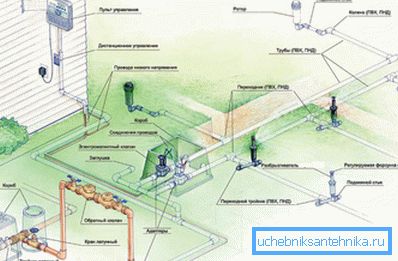
Note! If the pipes pass under the bed, then it may be necessary to increase its depth (from 25–30 cm to 40–50 cm). This is necessary in order not to touch the pipe when digging up the site.
- the operating conditions of the pipeline will be sparing - the pressure in the pipe is low, boiling water will not pass through it exactly, and the temperature outside will only be positive. Therefore, you can use almost any PP pipe. Even a regular PN10 pipe will last about half a century;
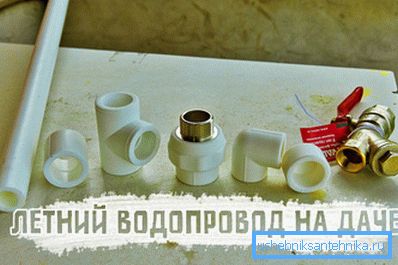
- it is undesirable to use pipes of very small diameter, as a permissible minimum you can stop at a diameter of 25 mm;
- even at the planning stage, you should think about laying a separate branch in the shower. It will cost a penny, and the benefits of such a decision will be noticeable in the warm season;
- also it is necessary to allocate in advance on the site diagram the points at which the connection will be made for irrigation. Their number can vary from 3 to 10, more is usually not required;
- as for fittings, the best way to connect pipes is detachable. Therefore, the most commonly used connection is American.
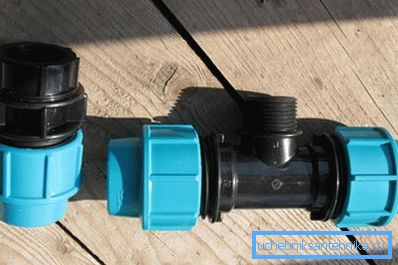
Water pipe laying
For example, consider a more complex option, when the irrigation water supply in the country of polypropylene pipes will be stationary.
Works are performed in this order:
- The first stage is digging trenches. Since there is no need to protect the pipe from negative temperatures in winter, its depth may be in the range of 25-30 cm;
Note! Be sure to comply with the slope of the bottom of the ditches in the direction of the drain hole. After the dacha season is over, it will be enough just to drain the water from the pipes, and they calmly winter through without gusts and deformations.
- pipes are being laid, the PP pipeline can be connected by soldering, but detachable connections are also permissible - this will facilitate possible repairs in the future. Although the leakage does not threaten with a catastrophe, it is desirable to achieve tightness of the connection, therefore when using threaded connections it is better to use FUM tape;
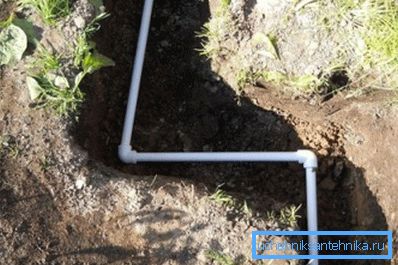
- as for the connection to the water source, it all depends on its type. This can be either a conventional water tank or a well or a pipe of a centralized water supply system. When connected to a centralized conduit, you can use a saddle - tee, which is worn on the pipe and fixed with bolts. Then a ball valve is installed and a hole is drilled after which a tap immediately blocks the flow of water;
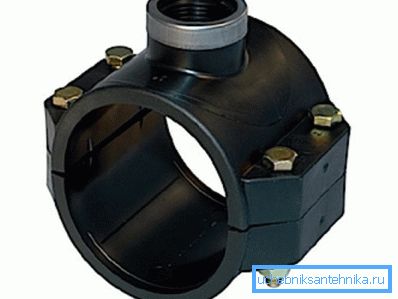
Note! Practice shows that the water quality is far from ideal, so it is advisable to install a filter in the place of tie-in to the centralized water supply system. This allows you to safely use different nozzles with small holes, they are guaranteed not to score.
- Also, the installation manual requires a release device for connecting the irrigation hose. Knowing the length of the hose segment, it is possible at the planning stage to calculate the required number of such outlets, each of which is equipped with a ball valve.

In the case of a temporary conduit, the sequence of actions is approximately the same, with the exception of earthworks - they are excluded, and the pipes are laid on the ground. In the case of water intake from a well or a well, a pump is also added to the circuit, but this does not greatly complicate the process. simply connect it correctly and do not forget about the filter.
Summarizing
The organization of a permanent or temporary water supply system for irrigation is not a whim, but, on the contrary, one of the signs of a real summer resident. With a minimum of effort and financial costs, a convenient irrigation system for the suburban area will be provided, and the irrigation time will be significantly reduced. It is also important that special knowledge is not needed for this, so a non-specialist can handle the work.
The video in this article shows an example of a simple and inexpensive suburban water supply.